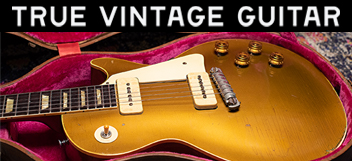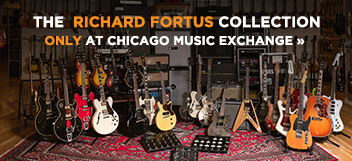-
THIS IS THE 25th ANNIVERSARY YEAR FOR THE LES PAUL FORUM! PLEASE CELEBRATE WITH US AND SUPPORT US WITH A DONATION TO KEEP US GOING! We've made a large financial investment to convert the Les Paul Forum to this new XenForo platform, and recently moved to a new hosting platform. We also have ongoing monthly operating expenses. THE "DONATIONS" TAB IS NOW WORKING, AND WE WOULD APPRECIATE ANY DONATIONS YOU CAN MAKE TO KEEP THE LES PAUL FORUM GOING! Thank you!
You are using an out of date browser. It may not display this or other websites correctly.
You should upgrade or use an alternative browser.
You should upgrade or use an alternative browser.
ABR vs Nashville?
- Thread starter jtunes
- Start date
Don
Well-known member
- Joined
- Dec 1, 2001
- Messages
- 5,733
Most folk consider the ABR-1 to be superior to the Nashville, unless they've run out of intonation adjusjment (the Nashville is wider).
A Nahsville would be loose on ABR-1 posts and the hole spacing is slightly different. It will usually fit, though.
I put an ABR-1 on my guitar that came with a Nashville by enlarging the ABR-1's hole to be the same size and taper as the holes in a Nashville. I used the Nashville's posts.
Hole spacing was not an issue.
A Nahsville would be loose on ABR-1 posts and the hole spacing is slightly different. It will usually fit, though.
I put an ABR-1 on my guitar that came with a Nashville by enlarging the ABR-1's hole to be the same size and taper as the holes in a Nashville. I used the Nashville's posts.
Hole spacing was not an issue.
jamisonlps
New member
- Joined
- May 30, 2005
- Messages
- 1,608
Just use the post for each respective bridge; aren't the bushings the same?
Don
Well-known member
- Joined
- Dec 1, 2001
- Messages
- 5,733
ABR-1 bridges don't use bushings.
The threaded rods that they're monted on thread directly into the wood.
The threaded rods that they're monted on thread directly into the wood.
Don
Well-known member
- Joined
- Dec 1, 2001
- Messages
- 5,733
Double post!
les strat
New member
- Joined
- Aug 22, 2004
- Messages
- 5,194
The Nashville also won't allow you to lower the tailpiece as much since it is wider. Often, the strings will catch on the back of the bridge if the tailpiece is too low (depending on your neck set).
BTW, if you run out of travel while intonating an ABR, turn the angled saddle around where the angle will be pointing the way you need to move it (if you can get it off the screw that is often bent when Gibson notches the saddle with a hammer!)
BTW, if you run out of travel while intonating an ABR, turn the angled saddle around where the angle will be pointing the way you need to move it (if you can get it off the screw that is often bent when Gibson notches the saddle with a hammer!)
toxpert
Active member
- Joined
- Jul 2, 2005
- Messages
- 3,068
My preference is the ABR-1 bridge. The original design works quite well and has that 'classic' look IMHO. You do need to have properly fitting/functioning saddles though. Gibson's lack of quality control for the holes that are machined into the brass saddles is a problem. Sometimes the hole is drilled too high, sometimes the hole is drilled too too low.
You can either be lucky and start out with good saddles (I never have been lucky) or you go through a lot of Gibson saddles and pick out the good ones or you use a quality third party, aftermarket source (e.g. Pigtail, etc) to get good ones.
I posted this saddle note recently in another thread:
"... Many of the saddles have misaligned adjust screw holes. Hole too high and the screw rises up off the bridge and saddle binds. Too low and vibration energy is focused through screw shaft and saddles rock side to side.
What you want are saddles that lie flat on top of the bridge and adjuster screw shaft that neither rises nor bottoms out throughout the entire range of adjustment.
I have seen lots of bridges with some of the saddles with the 'hole too high' error - Gibson's process somehow results in banging them flat = bent adjuster screws that don't work. For want of a properly made inexpensive part, the performance of a multi-thousand $$ guitar is compromised."
You can either be lucky and start out with good saddles (I never have been lucky) or you go through a lot of Gibson saddles and pick out the good ones or you use a quality third party, aftermarket source (e.g. Pigtail, etc) to get good ones.
I posted this saddle note recently in another thread:
"... Many of the saddles have misaligned adjust screw holes. Hole too high and the screw rises up off the bridge and saddle binds. Too low and vibration energy is focused through screw shaft and saddles rock side to side.
What you want are saddles that lie flat on top of the bridge and adjuster screw shaft that neither rises nor bottoms out throughout the entire range of adjustment.
I have seen lots of bridges with some of the saddles with the 'hole too high' error - Gibson's process somehow results in banging them flat = bent adjuster screws that don't work. For want of a properly made inexpensive part, the performance of a multi-thousand $$ guitar is compromised."
My preference is the ABR-1 bridge. The original design works quite well and has that 'classic' look IMHO. You do need to have properly fitting/functioning saddles though. Gibson's lack of quality control for the holes that are machined into the brass saddles is a problem. Sometimes the hole is drilled too high, sometimes the hole is drilled too too low.
You can either be lucky and start out with good saddles (I never have been lucky) or you go through a lot of Gibson saddles and pick out the good ones or you use a quality third party, aftermarket source (e.g. Pigtail, etc) to get good ones.
I posted this saddle note recently in another thread:
"... Many of the saddles have misaligned adjust screw holes. Hole too high and the screw rises up off the bridge and saddle binds. Too low and vibration energy is focused through screw shaft and saddles rock side to side.
What you want are saddles that lie flat on top of the bridge and adjuster screw shaft that neither rises nor bottoms out throughout the entire range of adjustment.
I have seen lots of bridges with some of the saddles with the 'hole too high' error - Gibson's process somehow results in banging them flat = bent adjuster screws that don't work. For want of a properly made inexpensive part, the performance of a multi-thousand $$ guitar is compromised."
.
P.Walker
Member
- Joined
- Apr 17, 2007
- Messages
- 941
i've had no problems with my nashville.
I've learned that the angle behind the bridge should be set somewhat close to the angle at the headstock.
The nashville bridge is raised higher, but I think that's optimum for the headstock angle. So i have never had the need to change to abr and screw that tailpiece all the way down. For me, it just creates unnecessary tension.
On my guitar, to satisfy that headstock angle, the tailpiece is moderately raised, also clearing the strings off the back of the bridge. everything in moderation for me..
I've learned that the angle behind the bridge should be set somewhat close to the angle at the headstock.
The nashville bridge is raised higher, but I think that's optimum for the headstock angle. So i have never had the need to change to abr and screw that tailpiece all the way down. For me, it just creates unnecessary tension.
On my guitar, to satisfy that headstock angle, the tailpiece is moderately raised, also clearing the strings off the back of the bridge. everything in moderation for me..
skylabfilmpop
New member
- Joined
- Dec 12, 2006
- Messages
- 588
ABR's sound better, although need more frequent maintenance. They have better attack sustain and fequency response and are more expressive sounding too. I have at this point compared the stock Gibson ABR to every tunomatic bridge except the pigtail and it just plain sounds the best. I have converted six nashville instruments to abr-1's (usually 90's era) and can't be happier.
avereste
Member
- Joined
- Apr 19, 2005
- Messages
- 377
At this point I'm very sceptical about differences in sound... specially in a live situation. Tone is subjetive.
But, from a mechanical point of view, the nashville is superior. More stability, stronger, "cleaner" in its height adjustments, no buzzz and more intonable.
But, from a mechanical point of view, the nashville is superior. More stability, stronger, "cleaner" in its height adjustments, no buzzz and more intonable.
Jurius
Active member
- Joined
- Sep 2, 2007
- Messages
- 1,399
At this point I'm very sceptical about differences in sound... specially in a live situation. Tone is subjetive.
But, from a mechanical point of view, the nashville is superior. More stability, stronger, "cleaner" in its height adjustments, no buzzz and more intonable.
I'm not a tech, but I'm yet to see and ABR I couldn't intonate so I don't see that as an advantage.
Also, IMHO, an ABR is plenty strong to do the job it was intended to do. Maybe someone who uses heavy gauge strings needs a stronger mechanical advantage, but I haven't bent an ABR yet.
Having used both, I prefer the ABR.
skylabfilmpop
New member
- Joined
- Dec 12, 2006
- Messages
- 588
Actually it looks stronger, but its not the majority of the nashvilles I have had on various guitars have collapsed. The Nashville on my first les paul cracked in half within 4 years, a recent gotoh nashville I had on my #1 es-335 collapsed after about two years. The original abr-1 on my 67 es-335 shows no deterioration. The problem is that while the abr-1 is solid on the bottom, a Nashville is not, it is actually hollow or more accurately ladder shaped. Additionally if you remove your strings and bridge and touch the nashville stud (pardon MY french!) it wobbles. It doesn't sit tightly in its threads. I do get a great sound from simply reaming an abr-1 to fit the Nashville studs but on three guitars I have taken the plunge and dowelled the Nashville anchor holes and properly installed an abr-1 and the results are fantastic. What the nashville does for gibson is give it some manufacturing leeway in setting the neck and installing the bridge posts thanks to the extended saddle throw. But an abr-1 equipped guitar is a little bit twangy, not like a tele but just enough to give note a bit of extra envelope and piano tone on the wound strings. Its only drawbacks are intonation drift and the retaining wire rattle, but to me the improvement is so vast that I manage that, checking my intonation more frequently and such.
avereste
Member
- Joined
- Apr 19, 2005
- Messages
- 377
I really would lke to try a nashville bridge but with ABR-1 studs sistem, driven into the wood. That would be perfect
Holgar
Member
- Joined
- May 11, 2003
- Messages
- 222
BillyBling
Well-known member
- Joined
- Feb 16, 2003
- Messages
- 4,031
I'm all about the Wrap Tail Bridges.......But, when it comes to the tune-o-matic's I'll take an abr-1 over a Nashville every time. The strings vibration gets the wood to resonate quicker due the lesser amount of metal the vibrations have to transfer through to get to the wood. Nashville bridges use those tone sucking cups.........
Now here weeeeeee go...........Once upon a time not a long ago.........
(copy right Slick Rick the Ruler 1988)
B
Now here weeeeeee go...........Once upon a time not a long ago.........
(copy right Slick Rick the Ruler 1988)
B
sidekick
New member
- Joined
- Jun 20, 2005
- Messages
- 3,060
IMO, the Nashville is a decent bridge that has that has greater intonation flexibility/advantage over an ABR-1 style. Arguably better designed posts too... But the latter is more aesthetically pleasing to my eye and somehow looks more 'right'.
Thin_Lizzy
New member
- Joined
- Jul 25, 2004
- Messages
- 1,345
Actually it looks stronger, but its not the majority of the nashvilles I have had on various guitars have collapsed. The Nashville on my first les paul cracked in half within 4 years, a recent gotoh nashville I had on my #1 es-335 collapsed after about two years. The original abr-1 on my 67 es-335 shows no deterioration. The problem is that while the abr-1 is solid on the bottom, a Nashville is not, it is actually hollow or more accurately ladder shaped. Additionally if you remove your strings and bridge and touch the nashville stud (pardon MY french!) it wobbles. It doesn't sit tightly in its threads. I do get a great sound from simply reaming an abr-1 to fit the Nashville studs but on three guitars I have taken the plunge and dowelled the Nashville anchor holes and properly installed an abr-1 and the results are fantastic. What the nashville does for gibson is give it some manufacturing leeway in setting the neck and installing the bridge posts thanks to the extended saddle throw. But an abr-1 equipped guitar is a little bit twangy, not like a tele but just enough to give note a bit of extra envelope and piano tone on the wound strings. Its only drawbacks are intonation drift and the retaining wire rattle, but to me the improvement is so vast that I manage that, checking my intonation more frequently and such.
I have one Nashville LP, the others are ABR. I like the ABR's better.
So, you're saying ABR on Nash-studs will be a improvement? I don't want to convert my guitar to ABR studs, but I think that's where most tone is sucked with a nashville bridge, isn't it?
So, I'm planning on staying with my nashville posts, but is it worth changing the bridge to ABR?
billd13
New member
- Joined
- Jul 2, 2006
- Messages
- 426
I changed the nashville to an ABR on my 82 Limited Edition, enlarging the ABR holes to fit. This guitar is an all mahogany, including the neck, with original Tim Shaw pickups. It made a big difference in tone and added sustain to an already vibrant guitar. Can't speak for another guitars, but, done this way it is completely reversible if you're not impressed with the results on your guitar.
jamisonlps
New member
- Joined
- May 30, 2005
- Messages
- 1,608
Can the Tone Pros locking ABR be retrofitted to Nashville posts?




